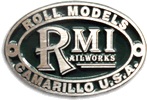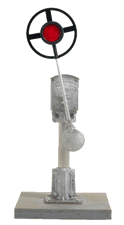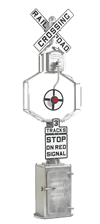

- Home
- RMI Store
- Locomotives
- Rolling Stock
- Track
- Structures
- Castings & Parts
- Signal Division
- Railroad Community
 |
 |
|
|
||
| For more products, pricing and ordering visit our online store CLICK HERE! | ||
 |
||||||||||||
| Los Angeles is well known for its long time romance with the automobile.
Not so well known is the fact that it was the home of the world’s largest street car and interurban rail system – Pacific
Electric. As railroad tracks, streets, and highways crossed and intersected each other, accidents and, as speeds increased,
fatalities increased at an alarming rate. Simple “Stop, Look, and Listen” signs no longer had sufficient impact. Live
watchmen swinging red lanterns work better but were costly and not completely reliable. In 1909, a Pacific Electric mechanical engineer, Albert Hunt, developed a mechanical signal using a red light swinging on the end of a pendulum. The first units were gear-driven. They were effective, but high maintenance. Another model, known as the “Magnetic Flagman”, was developed utilizing electro-magnets. The magnets were pulsed alternately to induce a swinging motion to the pendulum. The swing motion was also used to strike a gong. The combination light, motion, and sound proved most effective – producing a dramatic drop in accidents. Quantity production of these signals was taken up by the Magnetic Signal Company around 1914. The success of these signals on the P.E. system soon lead to their use throughout the United States, Canada, Mexico, and even Australia. Total sales exceeded 7,000 units. Per FRA information found on the internet, as of 2004 there were 215,224 railroad crossings in the United States. 1,098 of these were guarded by one more Wigwags. Not bad for a device that has been declared obsolete for over 60 years! Of these 398 were in California, 117 in Wisconsin, 97 in Illinois, 66 in Texas, 45 in Kansas, and at least one in another 39 states. Wigwags were produced in three distinct varieties – and Roll Models produces them all in several variants! |

|
High-Quadrant Signals Click to see more. |

|
Low-Quadrant Signals Click to see more. |

|
“Peach-Basket” Style Signals Click to see more. |
||||||
 |
 |
|||||||||||